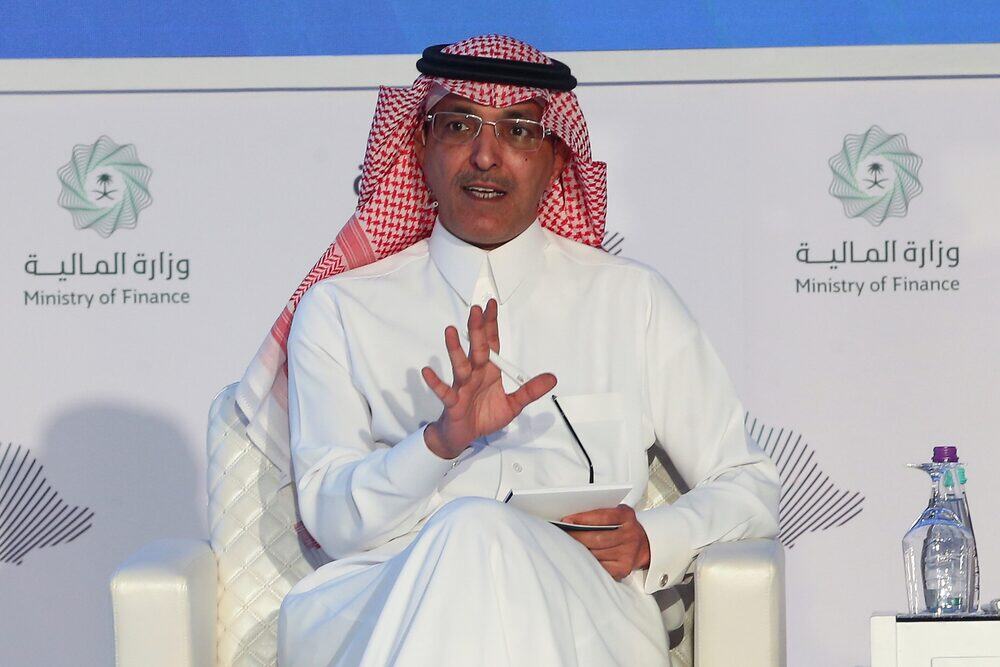Saudi Arabia’s financial market has surged past $2.4 trillion, making it the fastest-growing globally, as the Kingdom doubles down on fintech, digital payments and artificial intelligence to diversify its economy and cement its role as a financial center.
Finance Minister Mohammed al-Jadaan used the opening of the Money20/20 Middle East conference in Riyadh to reassure investors amid recent market declines, pointing to sharp gains in electronic payments, which climbed to 79% of total transactions last year from 18% in 2016, as evidence of progress toward a cashless economy.
“This growth reflects tangible progress in diversifying the economy and opening new horizons for investors,” said al-Jadaan, who also chairs the Financial Sector Development Program.
The Riyadh event, which drew ministers, regulators, and investors managing assets of more than $7 trillion, comes at a turbulent time for global markets. Geopolitical tensions and rising interest rates have clouded the outlook and pushed up the cost of capital.
Against that backdrop, al-Jadaan said Saudi Arabia is not merely adapting but contributing to shaping financial innovation.
“The Kingdom seeks to play an active role in shaping the future of finance through fintech and AI,” he stressed.
Riyadh as a financial hub
The minister said hosting Money20/20 highlighted Saudi Arabia’s emergence as a global financial hub, reflecting its deep commitment to innovation and entrepreneurship. The push forms part of Crown Prince Mohammed bin Salman’s Vision 2030, which aims to diversify the economy, boost resilience and build private-sector partnerships.
Global growth remains below historic levels, Jadaan said, with high borrowing costs and geopolitical frictions fueling uncertainty. But Saudi Arabia, he argued, is positioning itself as a provider of solutions, citing the digital revolution, AI and emerging sectors offering “unprecedented opportunities” for investment.
Fintech surge
The number of active fintech firms in Saudi Arabia has more than doubled in recent years, reaching 280 by mid-2025 compared with fewer than 20 a decade ago. The insurance sector expanded by 16.3% last year, while regulatory sandboxes have tested experimental financial products.
Al-Jadaan highlighted steps to deepen capital markets, including the launch of Saudi Arabia’s first mortgage-backed securities program. He also noted JP Morgan’s move to put Saudi riyal-denominated sovereign sukuk under review for possible inclusion in its benchmark Emerging Market Bond Index, a development that could expand investor access and broaden funding channels. “Youth are our most important investment,” al-Jadaan added, pointing out that more than 70% of Saudis are under 35, forming the driving force of Vision 2030 and the source of financial innovation.
Central bank: beyond supervision
Saudi Central Bank Governor Ayman al-Sayari said the fintech sector has tripled since 2022, attracting more than 9 billion riyals ($2.4 billion) in global investment.
He credited Saudi Arabia’s strategic location, tech-savvy population and supportive regulatory environment for luring innovators and investors.
The central bank, he said, is moving beyond oversight to actively foster innovation through initiatives such as its regulatory sandbox, Fintech Saudi, and instant payments platforms.
“Opportunities and risks in fintech cross borders,” he said, stressing the need for global cooperation and standardized frameworks to ensure sustainable growth.
According to al-Sayari, financial services will increasingly be shaped by artificial intelligence, tokenization and other technologies, with the Saudi central bank aiming to remain an open, forward-looking and trusted partner.
From retail-heavy to balanced markets
Capital Market Authority chairman Mohammed al-Kuwaiz noted that Saudi Arabia’s market had shifted from one dominated by retail investors to a more balanced mix of individuals and institutions.
“Before Vision 2030, retail investors accounted for 80–90% of trades. That brought liquidity but also volatility and herd behavior,” he said.
Today, institutional participation and a wider mix of investors – domestic and foreign, fundamental and technical – have reduced volatility.
While the market has fallen about 10% so far this year, al-Kuwaiz said overall swings had narrowed over the past eight years.
New digital services
The Riyadh gathering also marked the launch of new digital payment services. Google Pay and China’s Alipay+ announced their entry into the Saudi market, in cooperation with the central bank, expanding options for consumers and underlining the Kingdom’s bid to become a fintech hub.
Separately, the central bank unveiled the start of operations at Vision Bank, a new digital lender. The move is part of efforts to strengthen competition, reinforce financial stability, boost economic growth and enhance transparency and trust in the banking system.
Global backdrop
The conference took place against a global backdrop of uncertainty, with geopolitical tensions and trade disputes adding to the pressure of high interest rates. Al-Jadaan said these shifts had redefined the cost of capital and underscored the need for innovative financial solutions.
He stressed that Saudi Arabia is not merely weathering these global changes but actively shaping responses, including through digital transformation and AI.
“The future of finance will be built on innovation, technology and public-private partnerships,” he said.




